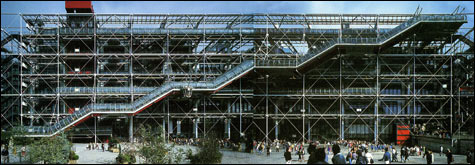
HIGH TECH: Terminal 4 at Madrid’s Barajas Airport typifies Paul Rogers’s skeletal style. |
A good architectural monograph is more than just a big colorful book with too-good-to-be-true photos; it’s a window into the heart and mind of the architect it profiles. Four new monographs reveal four architects’ personalities and four different ways of looking at — and even transforming — the world.
Richard Meier is, it’s clear, in love with order. HOUSES AND APARTMENTS (Rizzoli; 296 pages; $85) illustrates 35 years’ worth of his well-oiled machines for living. The book’s generous proportions (12-1/2 x 12-1/2), spare but elegant graphics, and nearly wordless spreads are of a piece with his pristine modernist monumentality.
Meier’s gleaming white country houses and perfectly sculpted urban apartment buildings are as cleanly designed as an iPod and as seductive as softcore porn. He composes his curving walls, serpentine stairs, and glass-wrapped galleries to provide the choreography for an idealized vision of domesticity. The result retreats into a glorious but icy perfection that is remote from life as most of us live it.
Steven Holl is more open to the impositions of an unruly world, taking the quirky character of a place and a client and giving them a poetic interpretation. ARCHITECTURE SPOKEN (Rizzoli; 304 pages; $75) talks and walks us through his work, which includes projects as diverse as the Simmons Hall Dormitory at MIT, the glowing glass Nelson-Atkins Museum of Art in Kansas City, Missouri, and the long, thin metal-paneled tube that contains a sewage treatment plant in Hamden, Connecticut. Holl’s buildings, and the book, are organized around ideas like “porosity” and “compression” that allow his strange and often contorted buildings to tell a story. Excerpts from his lectures articulate the intellectual and experiential qualities he wants his projects to embody. Unlike Meier, Holl doesn’t have a signature style. His childlike sketches show the origins of his fractured forms in emotional responses to landscapes and programs, rather than in a desire to reorder the universe.
Kenneth Powell’s RICHARD ROGERS: COMPLETE WORKS (Phaidon) documents the life work of a prodigious tinkerer. Rogers creates mechanistic structures, like the Centre Pompidou in Paris (a collaboration with Renzo Piano), that are suffused with a humanistic spirit. Most of his buildings use imposing steel skeletons to order urban environments, and smaller-scale elements of wood and masonry to maintain an ever-changing sense of vitality. This three-volume ($175) boxed set is stuffed with photos, sketches, autobiographical notes, and explanations illustrating his use of high-tech engineering to implement a social vision.
Paul Lukez’s SUBURBAN TRANSFORMATIONS (Princeton Architectural Press; 192 pages; $40) is a departure from the — let’s face it — self-aggrandizing quality of the typical architectural monograph. His collage-like proposals evolve out of interpretations of urban evolution that he has fastidiously documented as an academic and a practicing architect. Analytical time-lapse maps show how environments can be transformed using conceptual tools for defining space that are rooted in ancient history and modern technology. The book culminates in a series of site-specific proposals whose dreamy futuristic towers and lush tree-lined streets offer a blueprint for what today’s cities could be. This is a thoughtful volume that connects Lukez’s aggressive approach to design with his capacity for analysis and interpretation. And like all the books here, it offers an accessible approach to an idiosyncratic vision.